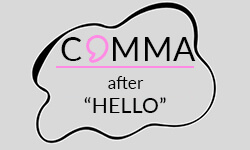
Using commas correctly in academic writing is crucial for maintaining clarity and structure, which facilitates comprehension. Many students struggle with comma placement because they are not fully versed in the extensive rules governing their use. To address this, we offer guidance on whether a comma should follow “hello,” alongside examples, and a practice sheet.
When to place a comma after “hello”
The word “hello” is grammatically classified as an interjection in the English language. Interjections are words or phrases used to express emotion, greeting, or a sudden reaction. It can be used in both formal and informal contexts. Additionally, “hello” can function as a noun in certain cases, referring to the act of greeting or the greeting itself.
Comma
Vocative case
No Comma
Informal use
Noun
Comma rules may vary depending on different Style Guides. Therefore, it is important to always check the guidelines for the Style Guide to keep your paper consistent. Essentially, always consider whether the sentence is clearer with or without a comma and conveys the correct meaning.
Comma after “hello”
There is one rule for when you use a comma after “hello” which is when you directly address someone, also known as a vocative case.
Vocative Case
The vocative case is used to directly address someone. The vocative comma is a punctuation mark that is used when the speaker is addressing someone specifically. When a speaker directly addresses an individual, that person’s name or title must be offset by commas. This can be at the beginning of a sentence or in the middle. Below, you’ll find examples of when to use a comma after “hello” to further your understanding.
No comma after “hello”
There are two cases for when you don’t use a comma after “hello.” The first one is when you greet someone in a more casual manner, such as through text messages or quick notes. The second rule is when you use “hello” as a noun. Both will be thoroughly explained below.
Informal Use
In more casual or informal conversations or digital communications, like text messages or chats, people often omit the comma after “hello” due to brevity and to maintain a conversational tone.
However, for proper punctuation in formal writing, it’s recommended to use the comma when addressing someone directly.
Noun
When “hello” is used as a noun, it refers to the act or instance of greeting someone. In these examples, “hello” is part of a larger sentence structure, acting as the subject or object, and is not directly followed by a comma because it’s not being used in a vocative case to address someone directly.
Test yourself!
Practice sheet
You can check your understanding of using commas after “hello” by taking this test. The correct answers to the 10 sentences can be found on the second tab.
- _____ and welcome to our annual meeting.
- After months of silence, his _____ was all she needed to hear.
- _____ class, today we’re going to learn about the solar system.
- The ______ at the party were drowned out by the music.
- _____ everyone, thank you for joining the meeting
- _____ Mrs. Smith, I’ve brought the documents you requested.
- His _____ lingered in my mind long after he left.
- _____ Mr. Johnson, could you please review this report?
- Each morning, her dog greets her with an eager _____.
- I could hear the _____ from across the crowded room.
- Hello and welcome to our annual meeting. (No Comma)
- After months of silence, his hello was all she needed to hear. (No Comma)
- Hello, class, today we’re going to learn about the solar system. (Comma)
- The hellos at the party were drowned out by the music. (No Comma)
- Hello, everyone, thank you for joining the meeting. (Comma)
- Hello, Mrs. Smith, I’ve brought the documents you requested. (Comma)
- His hello lingered in my mind long after he left. (No Comma)
- Hello, Mr. Johnson, could you please review this report? (Comma)
- Each morning, her dog greets her with an eager hello. (No Comma)
- I could hear the hello from across the crowded room. (No Comma)
- ✓ 3D live preview of your individual configuration
- ✓ Free express delivery for every single purchase
- ✓ Top-notch bindings with customised embossing

FAQs
If you use “hello” to directly address someone, you put a comma after it. If you use it as an interjection, you can use a period or an exclamation mark.
Since this is a vocative case where you directly address someone, you use a comma. However, if you know this person very well and are writing to them via digital communication (for example through text), you can omit the comma. Generally, you should use a comma in such cases.
Yes, a comma should always be added after you directly address a person or a group of people.
